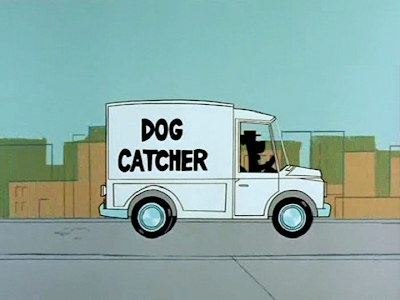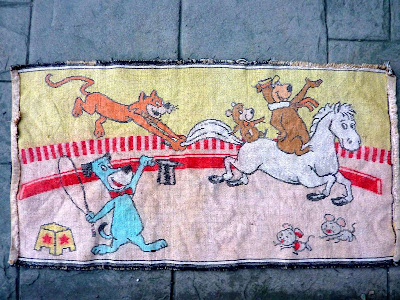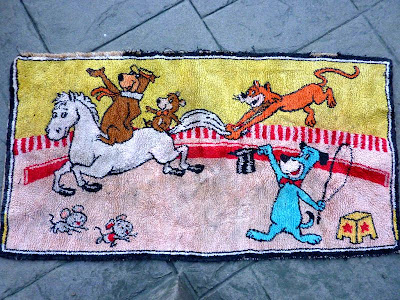If you want an indication of how celebrity gossip has changed over the years, I present as Exhibit ‘A’ this slice of life with Janet Waldo from the Radio-TV Mirror of June 1952.
This, of course, was before her role as the typical teenager of the future on The Jetsons. She was still known for her role on radio as the typical teenager of the present on Corliss Archer.
Today, show biz gossip consists of “news” items about celebrity train wrecks and pictures of stars wearing next to nothing. The 1950s were a gentler era. In between ads for shampoo, lipstick and home permanents, fans could read happy, fluffy stories about radio stars (Garry Moore, Jan Miner, Marie Wilson and so on) and, oddly, fiction “written” by characters on radio soap operas as if they were real people. You got to know what the Second Mrs. Burton really thought, not just what you heard on the air. It was all so innocent. Confidential and its ilk changed all that.
In honour of Janet’s birthday today, I’m posting the full article. Click on each page to enlarge it. Don’t expect dirt, viciousness or earth-shattering revelations. Unlike some fan magazine stories, there’s no reason to question the veracity of anything in this one. Janet and Bob Lee had a happy relationship that ended with his death in 1994. She comes across—on and off the air—as a kind, friendly and outgoing person. And she sounds the same as when Del Sharbutt was introducing her on radio more than 65 years ago. May she enjoy good health and be with us for many more years. ![]()
![]()
![]() Corliss Archer—Wonderful Whack
Corliss Archer—Wonderful Whack
By Elizabeth DownsThe telephone rang with its long, impatient-sounding buzz and Janet Waldo, with her usual bounding energy, rushed to answer it before it could ring again.
A man's voice sounded over the telephone. He identified himself as the representative of a Hollywood motion picture film company. "May I speak to your mother, please," he said, soothingly. "My mother!" exclaimed Janet. "Why, my mother doesn't live with me."
"What," came the surprised voice, the horrified voice. "You're only sixteen years old and you live alone?"
Janet mumbled something that sounded like "I'm really old enough to take care of myself," and hung up the telephone.
The pretty, pert star of ABC's "Corliss Archer" tilted her head to one side and said softly, "It was ever thus. For eight years I've been playing a sixteen-year-old girl and people just won't believe I'll ever grow up—that I am grown up—that, as a matter of fact, I'm grown up enough to be married and about to be a mother. But most people are like the film executive. They just won't believe me and I haven't the heart to tell them, very often.
"I had a terrible time on the radio show because I didn't want to disappoint the many fans of my Corliss Archer counterpart. Corliss is a part of me, somebody I love and understand, and I want people to still think of me as Corliss despite the fact that in real life I wanted to be my husband's wife and now a mother! I couldn't let the fans know until the last minute that I was going to have a baby. I just couldn't."
Odds are that Janet will still be acceptable as Corliss long after she becomes a mother because she still looks like Corliss, talks like Corliss, is Corliss in real-life. Her petite figure is just perfect for skirts and sweaters. Her long bob looks adorable in a teenager's dream of sophistication—the horse's tail coiffure. She has a peaches and cream complexion, twinkling brown eyes and a pert face that looks as naive as a high school sophomore's. If her looks are deceiving, the bubbling Waldo personality clinches the illusion. Janet is as effervescent, fresh and unspoiled as the teenagers she portrays so well. And it was this very freshness and charm which attracted Robert E. Lee, brilliant young writer of the Railroad Hour, four years ago when he asked Janet to be his wife.
"Oh, and he is," sighs Janet, "so wonderful! He's so beautifully patiently impatient with me."
Translated, that means Bob takes cute Janet and her many "household incidents" in his stride. Reserved, quiet, easy-going, Bob is a good balance for his bouncy, carefree wife.
Bob, as most husbands would, likes their attractive Sherman Oaks, California, house to appear shiny and spotless. He encourages Janet to see that it is in good order at all times. But Janet, who is as personally immaculate as they come, admits she'd rather visit her many friends than stay home and straighten out a room.
Janet's attempts at cooking are always good for a laugh to her friends. "I have people I've been trying to coax to dinner for years and they won't come. The cowards! They've been frightened by the propaganda they've heard." It's propaganda, however, which has been jointly spread by Mr. and Mrs. Lee over the four years of trial and error Janet has had in the kitchen.
Cooking, it seems, is not an art Janet has mastered, although she claims she's improved since that first terrible evening when Bob had invited some very important persons to dinner. Janet had insisted, as any good conscientious bride should, on cooking it herself. "It will flatter them," she explained to her dubious husband.
Came the eventful day, and for once Janet was detained until 5:30 P.M. at the studio rehearsing. The guests were expected at 6:30.
Undaunted, Janet popped her roast into the oven, along with the potatoes. "I learned later that the roast wasn't too good a cut of meat." Then, hurriedly, Janet began to put a tomato aspic together.
"You know," Janet says with just a trace of the mystified expression she wore that evening, "the aspic didn't freeze and in desperation I tried to serve it covered with hard-boiled eggs and chopped walnuts. It looked all right in the mold but when people started dishing it up, it looked like tomato soup. But that wasn't all. I had only purchased six rolls since there were just four of us and they caught on fire in the oven. Periodically, as I worked desperately over the hot stove, Bob would stomp into the kitchen. 'Isn't it done yet,' he'd whisper. 'I smell something that smells done!'
"At last, at 9:30, I served dinner. The guests were terribly polite—and so hungry that I guess they couldn't speak. The roast was positively rare—and tough. And the potatoes—well, you'd put your fork into them and they'd just scoot off the plate. It was a miserable dinner and, to this day, Bob doesn't speak of it but turns slightly pale whenever I bring up the subject."
So Janet and Bob don't take chances on important people any more. "We have my mother help or Bob has the dinner catered. We had important guests right after Bob hit upon this catering even though I told Bob I'd do much better. But he wouldn't listen to me. He just had the dinner brought in, before the guests arrived, and everything seemed perfect.
"Excepting," giggled Janet, "it was composed of the most wonderfully delicious little sauces over equally exotic solid food. We hadn't the vaguest idea what any of it was. Our guests were completely amazed at my having cooked this gourmet's delight. Bob had promised to kill me if I told them our dinner was catered so I graciously accepted their compliments. When the women began asking for the recipes, I was more embarrassed than I'd been when dinner didn't turn out at all. Then I had an idea.
" 'Oh, you must ask Bob,' I said in my most casual manner, not looking at him. 'They're his favorite recipes!' Poor Bob. He knows less about cooking than I do. He hemmed and hawed over each dish. Any resemblance to the ingredients he finally concocted and the beautiful dishes on the table was more than accidental—it was amazing!"
Janet and Bob used to eat many meals out. But this was before Bob gave Janet a deep freeze for a birthday present, thinking that perhaps this would help her learn to cook. The freezer came stocked with food—steaks, hamburger, ice cream. Janet learned how to defrost and broil steaks in no time and they lived like royalty on steaks and ice cream. But now Janet is worried—"The only thing that's left is hamburger, and how do you fix forty pounds of hamburger so that's it's edible for forty meals?"
'T'heir favorite meal is Sunday dinner—which Janet's mother always cooks. "We never miss that. Although Bob loves to fly his own plane on Sunday, his only free time, he always makes it back to Mom's house for dinner. Once we'd had a quarrel and the only way I could think to punish Bob was by depriving him of my mother's dinner for a month. He was really heartbroken and made up immediately."
Bob and Janet have such fun together that there's little' time left for quarreling. "Just like any newlyweds, we used to squabble, but we've mellowed. Bob has such a wonderful sense of humor he has me laughing—at myself—in no time. But, then, we never got really mad. For example, I never thought of going home to Mother. Now, I wouldn't dare because Bob would be there, waiting for dinner."
Life today has never seemed fuller or richer to the Lees, who are eagerly awaiting their baby's arrival, due early in June, Janet thinks. They don't really care what their first-born is, boy or girl—"just so it's a little baby," sighs Janet. Janet is busy turning her spare bedroom into a nursery with a dream of a baby bed and oodles of baby clothes which she loves to show off.
The Lees' friends used to kid them about the baby by insisting "it" would play second fiddle to their dog, Lady Ophelia. As a lady, "Ophie," a pedigreed Welsh terrier, gets the run of the house.
"We love Ophie as much as people," defended Janet, "and when she had two little puppies we named the first one People. The second we call Perkimore, after its vitamins. You bet Ophie, Pepe and Perky have a very special place in our hearts. But really nothing will compare to the love we'll have for our baby. We think we'll try for a family of two or three, just like Ophie."
Having been in the entertainment business for many years, Janet is wisely aware of the pitfalls it offers a woman combining career with marriage. "And I don't intend it's happening to me," she said.
"I've turned down many opportunities, and even the chance of playing Corliss on TV, just to keep my life uncluttered and my time free for my husband. He's tried to keep free time for me by beginning his writing hours at 5 A.M. This doesn't affect me, as I usually don't arise until 9. He doesn't even take time from his work to come in and wake me, instead he calls on his phone from the next room."
That isn't as confusing as it sounds. The Lees have their own telephones, and for good reason, too. Janet has telephonitis.
"Bob used to die because I tied up the line for hours just chattering—a habit I love and wouldn't break. As he worked at home he couldn't get important calls, so he made a bargain with me. If I'd answer the phone, 'Lawrence and Lee Productions' —which is his and business partner Jerry Lawrence's title—like a secretary in his office, then he said I could have a line of my own. We tried it and it works just beautifully. Now he doesn't dare use my phone without asking."
While this solved one problem, it didn't solve another. Even though Janet can't tie up his line, Bob finds she is still oblivious to everything while chattering on her own phone. Therefore, he has to write her notes concerning pertinent business, such as the eggs she's left cooking on the stove, or the fact they've guests coming in twenty minutes.
"And he can be so stuffy," she wailed, "when he says in his most authorish tone, 'We'll be finished in five minutes, won't we?' We, meaning me. That's the way he talks to me when he's annoyed about something. 'My, we're burning a lot of things, aren't we?' But I love him, he's so wonderful!"
Janet's idea of sheer heaven would be to work with her husband on a radio or TV show. "Then we'd be together every minute!"
As it is, the Lees share more hours together than the average couple. They bought their attractive redwood bungalow, on a charming street in Sherman Oaks, fifteen minutes after they'd first seen it! They noticed the compact valley house and fell in love with it. The real estate agent was right there and in no time at all they were home owners. Janet claims the house still isn't furnished properly.
But the only real complaint she has, if she has any, is her lack of offers to portray dramatic roles. Roles as adult and sophisticated as she'd actually like to be—and sometimes imagines that she is.
"Oh, well," smiled Janet with her most grown-up look, "I'll have you know a talent scout asked me recently if I thought I could play a young lady. Isn't that peachy? I've really never been so flattered!"
![]()
![]()
![]()
![]()
![]()
![]()
![]()
![]()
![]() The old guard of Bob Gentle, Monty and Art Lozzi didn’t have a hand in this cartoon. The old guard was giving way to new artists. The backgrounds are credited to Phil Lewis, Rene Garcia and Don Watson. Lewis started as an in-betweener during the last gasps of the Warners Bros. studio. He died a couple of years ago. Rene worked on a bunch of shows in the mid to late ‘60s. Someone on Tumblr posted this great colour picture of him with some Flintstones backgrounds.Watson worked on a pile of H-B shows in the ‘60s as well and was still drawing until at least a few years ago. All three of them ended up at Filmation at one time or another.
The old guard of Bob Gentle, Monty and Art Lozzi didn’t have a hand in this cartoon. The old guard was giving way to new artists. The backgrounds are credited to Phil Lewis, Rene Garcia and Don Watson. Lewis started as an in-betweener during the last gasps of the Warners Bros. studio. He died a couple of years ago. Rene worked on a bunch of shows in the mid to late ‘60s. Someone on Tumblr posted this great colour picture of him with some Flintstones backgrounds.Watson worked on a pile of H-B shows in the ‘60s as well and was still drawing until at least a few years ago. All three of them ended up at Filmation at one time or another. 



































































































































































